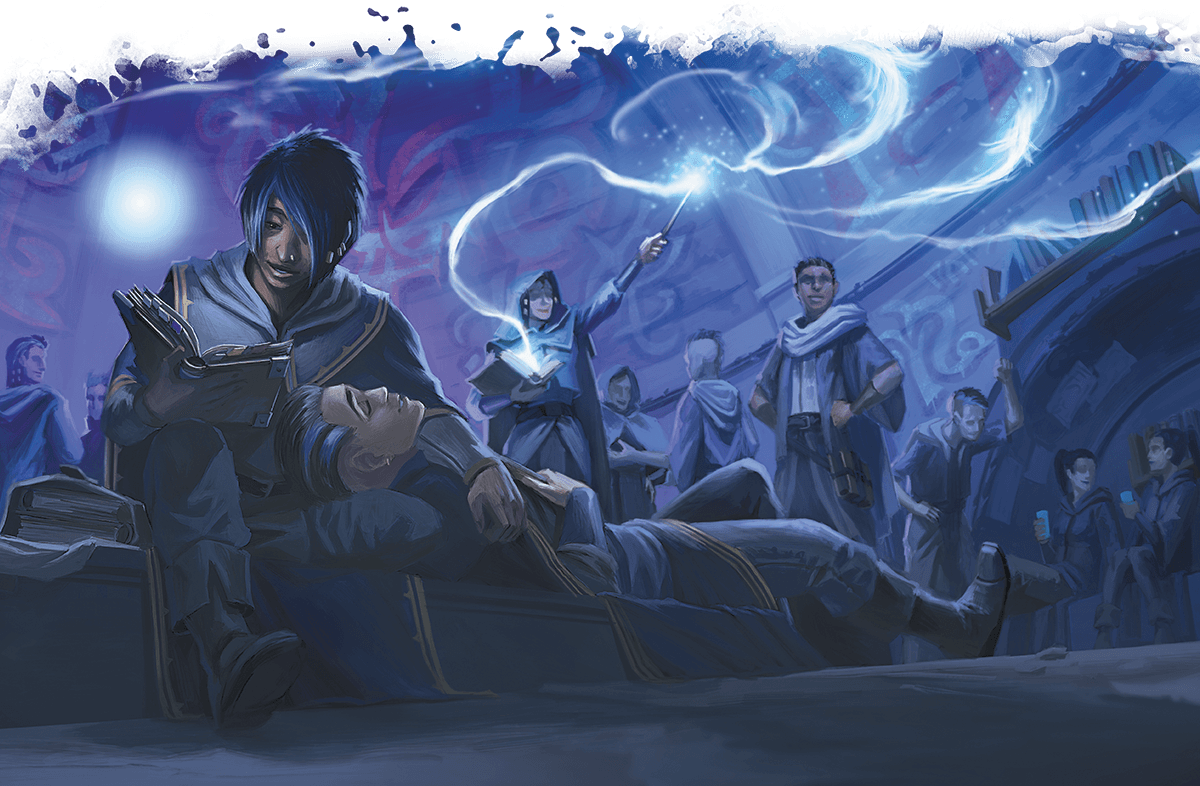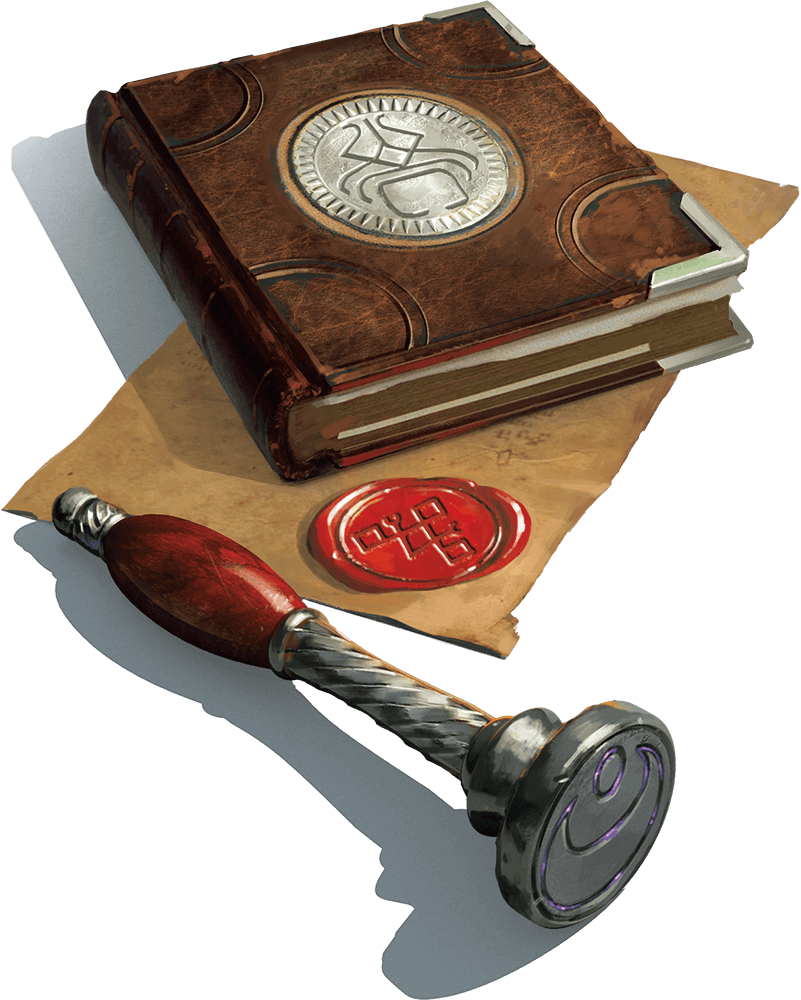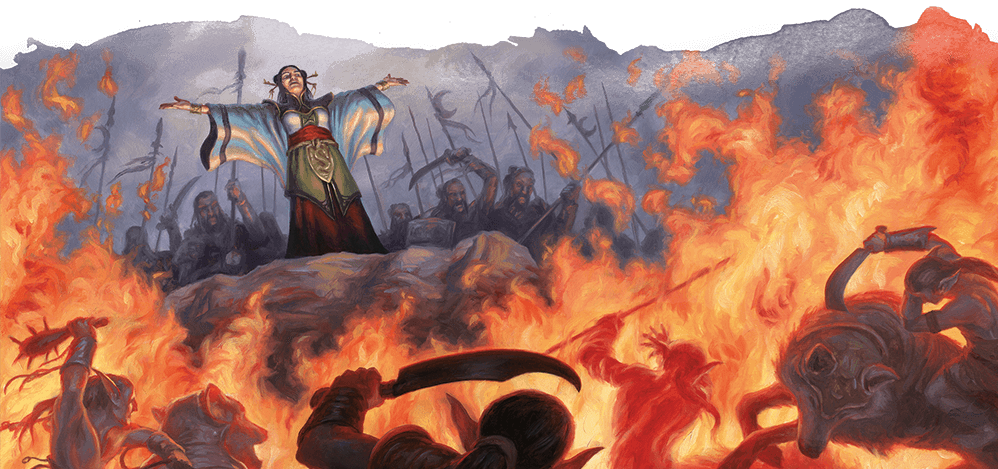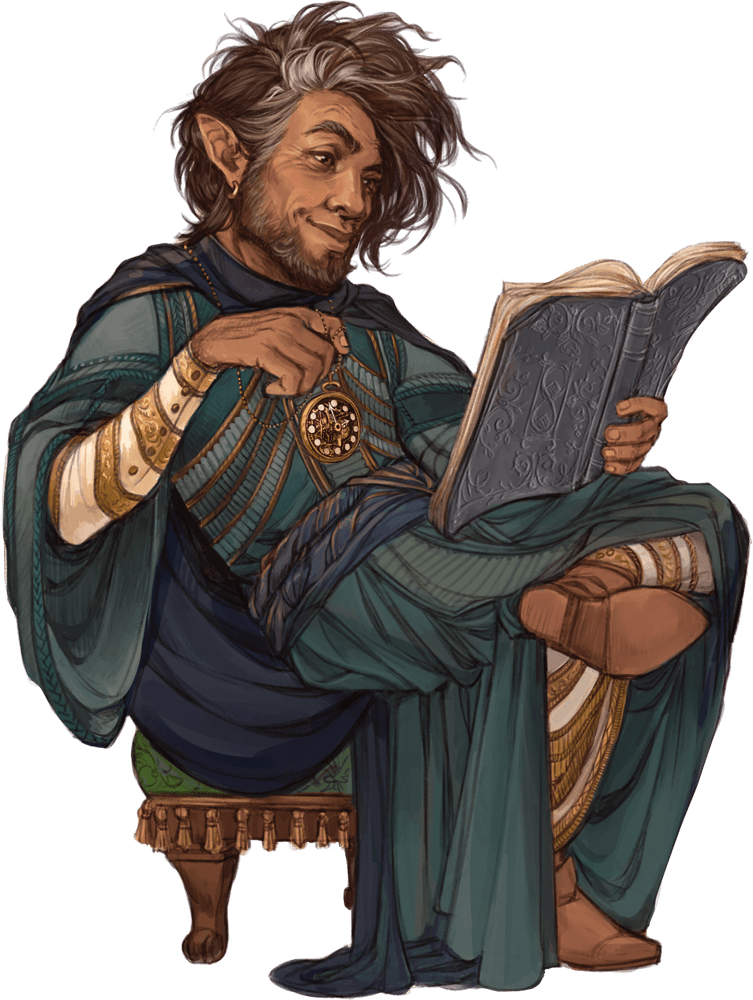“Books are a uniquely portable magic.”
-Stephen King
Wizards are without a doubt the most bookish class in Dungeons & Dragons. While other enchanters might receive their powers from bloodlines and eldritch patrons, wizards fill out their spell slots the old-fashioned way - through careful study and transcription of the printed page.
While there may be flashier schools of wizardry in D&D, if you’re someone who loves the image of an elderly magus who’s so fond of his spell tome that he actually managed to create a spectral version of it to fight alongside him, then a certain Arcane Tradition from Tasha’s Cauldron of Everything is perfect for you - particularly with this week’s release of Candlekeep Mysteries, a collection of adventures featuring the grandest library of the Forgotten Realms as a hub.
In other words, there’s no better time to hit the books and experiment with the Order of Scribes.

Order of Scribes features
Order of Scribes wizards specialize in quickly copying spells into their spellbooks, modifying spell damage types, gaining tactical advantage during combat or exploration, crafting spell scrolls, and surviving lethal blows by sacrificing bits of their magic.
- They gain two level 2 abilities. The first of these, Wizardly Quill, grants the wizard a magical quill that doesn’t require ink and can copy down spells at 2 minutes per spell level. Normally, wizards must spend a whopping 2 hours per level copying a spell, which forces this activity to be done in the downtime before or after a long rest. The Order of Scribes wizard faces no such problem, and could potentially scribble down the most potent magics from an enemy archmage’s stash in the middle of a dungeon crawl while the rest of the party stays alert.
- Their second level 2 feature, Awakened Spellbook, causes a sentience to emerge in the wizard’s spellbook. The wizard can now use the book as an arcane focus and cast spells as rituals using their normal casting time. They can also quickly replace their spellbook after a short rest without spending odious amounts of time and gold. (I played in an Out of the Abyss game with a gnome wizard who lost his spellbook after a drow battle and would’ve killed for this feature.) But the grand slam here is the ability to temporarily replace a spell’s damage type with another you possess that’s of the same level. (So no cantrips allowed.) More on this later, but yes, this does mean that if you cast the level 4 spell Ice Storm and have Sickening Radiance (also level 4) in your spellbook, you can shoot icicles that do radiant damage.
- Manifest Mind is the Order of Scribes level 6 ability. With this, the wizard can summon the mind of their Awakened Spellbook, getting something that’s a cross between a familiar and the Arcane Eye spell that possesses darkvision, can scout up to 300 feet ahead, and is intangible and impervious to damage. (It can disappear if hit with a Dispel Magic spell, though.) Best of all, the wizard can cast spells from the spectral mind’s space a number of times equal to their proficiency bonus. This grants the wizard a tremendous degree of mobility and range, meaning they can certainly bombard a den of undead from 300 feet away with those aforementioned radiant icicles if the occasion calls for it!
- The 10th level Order of Scribes feature is Master Scrivener, which lets the wizard pump out a scroll for level 1 or 2 spells after a long rest like a humanoid printing press. These scrolls are enhanced and count as one level higher than normal when used. Essentially, this gives the wizard a potentially endless array of magics that can be relied upon in a jiffy for the sake of reserving spell slots, and it’s a good idea to make this scroll creation process a daily ritual for any character choosing this Arcane Tradition.
- One With The Word is the final ability obtained at level 14. It grants an advantage on all Intelligence (Arcana) checks and allows the wizard to use a reaction to have their spectral mind absorb all damage from a blow. The mind will immediately vanish, and 3d6 must be rolled in what amounts to a potentially unpredictable outcome where the spellbook will temporarily lose spells of your choice that have a combined level equal to that roll or higher. (For instance, if the 3d6 roll is 6, you could dismiss one 6th level spell, two 3rd level spells, or some other combination.) The lost spells can be cast again once the wizard finishes 1d6 long rests. All in all, One With The Words carries risky consequences, but when you’re hit with a Beholder’s Disintegration Ray, this feature will definitely come in handy.
Benefits of the Order of Scribes
If nothing else, Order of Scribes wizards are versatile. They circumvent several of the busywork restrictions that plague other Arcane Tradition practitioners, such as the hefty time required to copy down new spellbook entries. While they’re not exactly tanks, they can take more than a few hits and remain standing thanks to One With The Word, and their ability to cast magic from afar via Manifest Mind and swap around damage types will surely appeal to D&D tinkerers who love crafting efficient character builds, tactically assessing a battle map and figuring out potent magic combos.
This degree of customization also extends to the Manifest Mind feature, which offers a myriad of roleplaying possibilities. The rules in Tasha’s Guide to Everything state that the mind resembles a ghostly tome, a cascade of text, or a scholar from the past, but generous DMs might be willing to have their players create an appropriate form that ties into a character’s backstory. Perhaps, for example, the mind could take on the appearance of the wizard’s long-departed spouse, representing the eternal connection of two hearts united as one.
Drawbacks of the Order of Scribes
The Order of Scribes tradition has been called niche by some, largely because its skill set is designed to thrive in a campaign that features varied foes with unusual resistances, as well as one that actually follows D&D’s rules when it comes to the time limits required for casting spells as rituals and copying down magic. If your DM is one who handwaves such minutiae, be aware that some of this Arcane Tradition’s more nuanced capabilities may remain on the back burner. If you’re also fearful of temporarily losing spells, the swingy nature of One With The Word may also seem like an underwhelming 14th level ability.
Some D&D fans who keep up with Unearthed Arcana have also critiqued the Order of Scribes as unoriginal, mostly because it’s a remix of a now-scrapped subclass for the Artificer known as the Archivist. Others prefer the more powerful Unearthed Arcana rules for the Order of the Scribes’ Awakened Spellbook, since they enabled players to swap a spell’s damage type with that of any spell in their spellbook - whereas the finalized rules restrict this to a spell of the same level.
Spells
Playing an Order of Scribes mage is all about amassing as many damage types as you can. The Awakened Spellbook text specifically states that you’re allowed to replace a spell’s damage type with one that appears in another spell of the same level, indicating that as long as it shows up in the spell’s text somewhere, you’re good to go. Keeping that in mind, here are some useful loadout possibilities from the Player’s Handbook, Xanathar’s Guide to Everything, and Tasha’s Cauldron of Everything.
As a reminder, D&D’s 13 damage types include acid, bludgeoning, cold, fire, force, lightning, necrotic, piercing, poison, psychic, radiant, slashing, and thunder.
- 1st Level spells: Chromatic Orb (acid, cold, fire, lightning, poison, thunder), Catapult (bludgeoning), Ice Knife (piercing), Magic Missile (force)
- 2nd Level spells: Cloud of Daggers (slashing), Dragon’s Breath (acid, cold, fire, lightning, poison), Dust Devil (bludgeoning), Phantasmal Force (psychic), Shatter (thunder)
- 3rd Level spells: Erupting Earth (bludgeoning), Glyph of Warding (acid, cold, fire, lightning, thunder), Spirit Shroud (cold, necrotic, radiant), Summon Undead (necrotic, poison)
- 4th Level spells: Blight (necrotic), Elemental Bane (acid, cold, fire, lightning), Ice Storm (bludgeoning, cold), Mordenkainen’s Faithful Hound (piercing), Phantasmal Killer (psychic), Sickening Radiance (radiant)
- 5th Level spells: Bigby’s Hand (bludgeoning, force), Cloudkill (poison), Cone of Cold (cold), Dawn (radiant), Enervation (necrotic), Immolation (fire), Transmute Rock (bludgeoning)
- 6th Level spells: Chain Lightning (lightning), Investiture of Flame (fire, cold), Investiture of Stone (bludgeoning, piercing, slashing), Sunbeam (radiant), Tasha’s Otherworldly Guise (fire, poison, radiant, necrotic)
- 7th Level spells: Crown of Stars (radiant), Finger of Death (necrotic), Prismatic Spray (acid, cold, fire, lightning, poison), Whirlwind (bludgeoning)
- 8th Level spells: Feeblemind (psychic), Illusory Dragon (acid, cold, fire, lightning, necrotic, poison) Sunburst (radiant)
- 9th Level spells: Blade of Disaster (force), Prismatic Wall (acid, cold, fire, lightning, poison), Weird (psychic)
This list doesn’t take into account the non-wizard spells and damage types that might become accessible if you’re following D&D’s multiclass rules. (Check out our How to Multiclass for Beginners article for more info!)
Speaking of multiclassing, one combination that’s achieved notoriety on the internet is an Order of Scribes Wizard who takes two levels of Tempest Cleric, giving them the ability to deal maximum Thunder or Lightning damage to an enemy once per short rest via Channel Divinity. Considering the damage swapping capabilities of the Order of Scribes, this could either be a match made in heaven or insanely overpowered, depending on whether you’re a player or a DM!
Feats
To supplement the Order of Scribes’ skillset, consider the following feats, which can add magic from other classes to your disposal without relying upon multiclassing or increase the wizard’s mobility and hardiness.
- Elemental Adept - This feat will let your spells ignore resistance to a certain damage type - acid, cold, fire, lightning or thunder - and also lets you treat any 1 on a damage die as a 2. This can be handy if you need to swap the damage type of a certain spell but don’t have anything prepared in your spell slots that’s of the same level.
- Eldritch Adept - To amplify the versatility of the Order of Scribes wizard, why not dip into the Warlock’s magic pool? Invocations like Eldritch Sight, which lets you cast Detect Magic at will, can be fantastic for conserving spell slots for those big damage swapping attacks that you specialize in.
- Fey Touched - Learning Misty Step for free and an additional 1st level spell - both of which can be cast once per long rest without expending a spell slot - is immensely useful, especially if you decide to use your spellbook’s spectral mind for scouting purposes and need to quickly teleport to its side.
- Magic Initiate - This feat will give you two cantrips from the bard, cleric, druid, sorcerer, or warlock spell lists, and even though cantrips can’t benefit from Awakened Spellbook, they’re still great to have. Plus, you get an extra 1st level spell to go along with them!
- Shadow Touched - Similar to Fey Touched, this lets you learn Invisibility for free and an additional 1st level spell that can be cast once per long rest without expending a spell slot. Imagine staying unseen to all as you unleash your magics from the space of your spectral mind. Who said that wizards can’t act like rogues?
- Telekinetic - This is an interesting choice that gives you an invisible Mage Hand and also lets you telekinetically shove one creature you can see within 30 feet. Once again, this supplements the Order of Scribe’s high mobility and can even serve as a unique way to maneuver allies around the battlefield.
- Warcaster - Warcaster’s just an easy choice for all wizards, letting them have an advantage on Constitution saving throws to maintain concentration and granting the ability to cast a spell as a reaction when attacks of opportunity are provoked.
The Order of Scribes wizard is one who trusts in the power of the book and knows that the quill is mightier than the sword. Consider playing this unique Arcane Tradition in the just-released Candlekeep Mysteries - for who better than a scribe to investigate the enigmas that lurk within mysterious grimoires?
For more on wizards, be sure to check out our overview of wizardly traditions in Wizard 101: A Beginner’s Guide to the Arcane Arts, as well as our in-depth looks at the School of Abjuration and the School of Evocation. And if you’d rather play another class, our entire Class 101 series is at your disposal.
Jeremy Blum (@PixelGrotto) is a journalist, gaming blogger, comic book aficionado, and fan of all forms of storytelling who rolled his first polyhedral dice while living in Hong Kong in 2017. Since then, he's never looked back and loves roleplaying games for the chance to tell the tales that have been swirling in his head since childhood.












-
View User Profile
-
Send Message
Posted Sep 6, 2021That's a question only your own DM can answer as even with the assumption that a damage resistance/immunity counts for a damage type, "all" damage doesn't mention any specific types you can swap for. I think it's getting further away from rules as intended though, as I doubt Wizards of the Coast intended for there to be any one spell that everyone would just take to gain access to all damage types for that level.
This is why I'm of the opinion that rules as intended is that you can swap damage types only among damaging spells, plus I think it makes sense thematically, i.e- the wizard uses their knowledge of spells that deal lightning damage to transform fire into lightning and so-on.
But like I say, that's just how I'd rule it (the rules as written aren't clear enough either way); ultimately it's for your DM to decide if they'd allow it, and whether they think a player is abusing it somehow or not. Also, for a wizard specifically 9th level spells aren't actually that hard to learn; you can learn two spells for free at each level, and get your first 9th level slot at level 17, so could know eight spells to swap among by level 20, barring any extras you pick up.
-
View User Profile
-
Send Message
Posted Sep 7, 2021I'm sure you're right, and what you're saying makes more sense than some other interpretations. I was simply curious just how much OoS allowed [Tooltip Not Found] to be... well, abused.
-
View User Profile
-
Send Message
Posted Dec 1, 2021There is potential synergy with OoS Wizard and Tempest Domain Cleric, as you can change the damage type of any spell to lightning or thunder damage, so long as you have another spell that deals that type of damage (there are plenty of spells out there that can deal any form of elemental damage). That is a powerful combo, because you can use Destructive Wrath on lightning bolt, fireball, cone of cold, and eventually chain lightning and meteor swarm! Destructive Wrath doesn't specify that it has to be a cleric spell, it just has to deal lightning or thunder damage. This combination is good for any blaster mage.
You could do the same with sorcerer. Use Transmuted Spell to change the damage type of any elemental spell to lightning or thunder damage. Either way, this can also help you circumvent damage resistances, as not many creatures are resistant to thunder damage. Combine this with Heightened Spell or Quickened Spell.
-
View User Profile
-
Send Message
Posted Jan 19, 2022Great article. It would be great if you had a paragraph discussing common mechanical issues with this subclass, in particular the discussion of the point of the conjured quill in terms of spell expenses. Have actually ended up sticking to the UA version of half of each because it makes no sense why they ruined that.
-
View User Profile
-
Send Message
Posted Feb 22, 2022Start with fireball, Change to bludgeoning damage, now it's just 'Ball.'
-
View User Profile
-
Send Message
Posted Feb 22, 2022Ha!
Phonetically, I'd probably go with "Iron Ball"...and it would literally be just a giant, metallic weight that expands to flatten everyone in the space.
-
View User Profile
-
Send Message
Posted Mar 3, 2022chances are that James Haeck left D&D beyond and this series was his job
-
View User Profile
-
Send Message
Posted Apr 4, 2022I'm gonna make a gnome wizard with this subclass who is literally me irl.
-
View User Profile
-
Send Message
Posted Jul 22, 2022Can you use the Awakened Spellbook feature to replace more than one damage type in a spell? For example, can you use it to replace both the piercing damage and cold damage when casting Ice Knife. If you know Chromatic Orb for example, can you cast Ice Knife and have it do acid damage for the single target damage and the area damage?
-
View User Profile
-
Send Message
Posted Jul 22, 2022Since, it doesn't specify one damage type in the wording, I would say that's a reasonable use of the feature. Not a common case, but not a game breaker either.
-
View User Profile
-
Send Message
Posted Dec 15, 2024Have admit this subclass is the nerd drug for my wizarding. Hopefully it will return to 2024 rules, assuming my games use them (questionable I admit.)